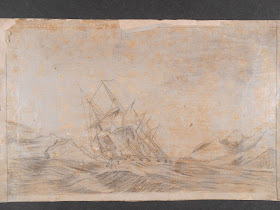 Augustus Alexander Warren was a warrant officer with the United States Navy in the mid-1800s. He was born to a French mother and an English father in Havre, France, in February of either 1826 or 1827. When a young man, Warren emigrated to Kittery, Maine, where he became a U.S. citizen in 1853 and received his commission as a sail-maker with the Navy the same year. Soon after, he set to sea on the USS Decatur to defend Seattle against "all the Indians occupying the Northern portion of the United States." Warren also sailed in support of the Charles Francis Hall Arctic expedition in 1871 and along the coast of South America in the 1880s.
Augustus Alexander Warren was a warrant officer with the United States Navy in the mid-1800s. He was born to a French mother and an English father in Havre, France, in February of either 1826 or 1827. When a young man, Warren emigrated to Kittery, Maine, where he became a U.S. citizen in 1853 and received his commission as a sail-maker with the Navy the same year. Soon after, he set to sea on the USS Decatur to defend Seattle against "all the Indians occupying the Northern portion of the United States." Warren also sailed in support of the Charles Francis Hall Arctic expedition in 1871 and along the coast of South America in the 1880s.
 The Warren Papers are a wonderful example of the wondrous variety that can be enclosed within a single-box collection and of the fascinating lives that can be explored through the breadth of documents found therein. Among other things, this box contains the original manuscripts of Warren's sea adventures, his official papers of citizenship and naval commission (the latter signed by Franklin Pierce), many of his letters home, and daguerreotypes of him and two other family members.
The Warren Papers are a wonderful example of the wondrous variety that can be enclosed within a single-box collection and of the fascinating lives that can be explored through the breadth of documents found therein. Among other things, this box contains the original manuscripts of Warren's sea adventures, his official papers of citizenship and naval commission (the latter signed by Franklin Pierce), many of his letters home, and daguerreotypes of him and two other family members. Despite these interesting items, what we found most striking are the numerous pencil drawings, some colored and others not, that are a significant part of the collection. As a sail-maker, Warren was by necessity an amateur draftsman; his logbook is filled with precise geometrical illustrations of the numerous types of sails required by navy ships at the time, complete with highly detailed measurements and instructions for constructing them aboard ship. These drawings are complemented by thrilling scenes of ships amid icebergs and touching images of an imagined reunion with his wife upon his eventual return home.
Despite these interesting items, what we found most striking are the numerous pencil drawings, some colored and others not, that are a significant part of the collection. As a sail-maker, Warren was by necessity an amateur draftsman; his logbook is filled with precise geometrical illustrations of the numerous types of sails required by navy ships at the time, complete with highly detailed measurements and instructions for constructing them aboard ship. These drawings are complemented by thrilling scenes of ships amid icebergs and touching images of an imagined reunion with his wife upon his eventual return home.
To explore the rich and fascinating depths of one ordinary man's life, humbly contained within a single box, ask at Rauner for MS-868 Box 1. A finding aid for the collection is available.

